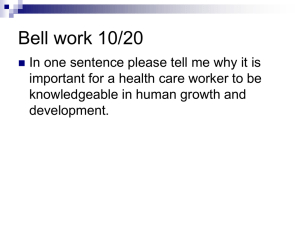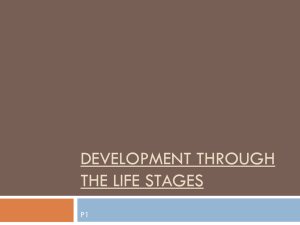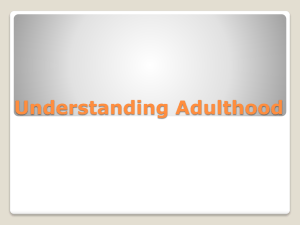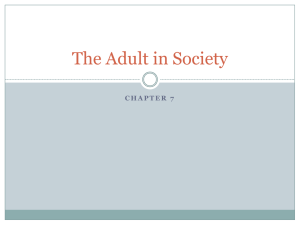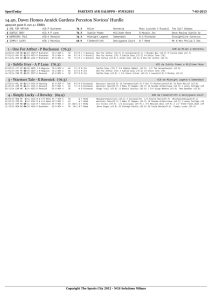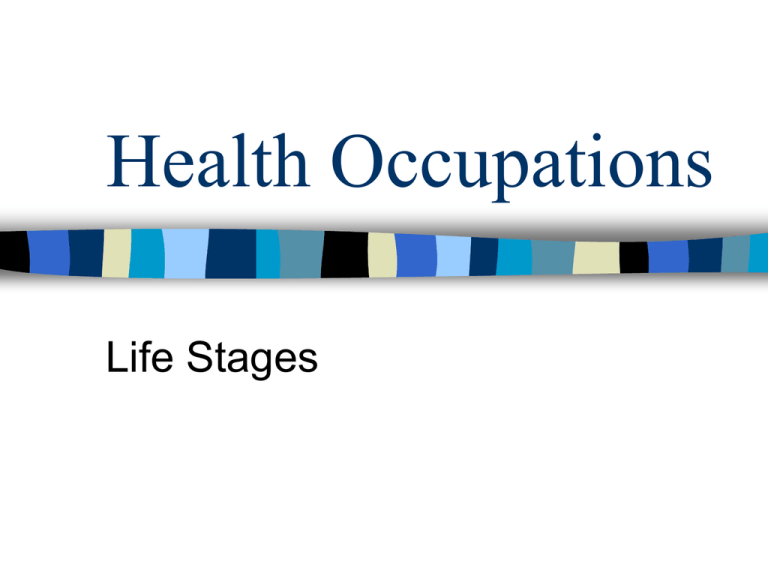
Health Occupations
Life Stages
Growth & Development
Begins @ birth, ends @ death
During all stages, individual needs must
be met
Need to be aware of the various stages
& needs in order to provide quality
health care
Life Stages
Individuals vary, but everyone passes through
certain stages of growth & development
Four main types of growth & development in
each stage
– Physical – body growth, muscle & nerve
development, body organ changes
– Mental – development of the mind, problem
solving, judgment, & coping
– Emotional – feelings, love, hate, joy, fear,
excitement
– Social – interactions & relationships with others
Life Stages
Each stage has own characteristics &
contains specific developmental tasks
Tasks progress from simple to complex
Each stage establishes foundation for
next stage
Rate of progress varies (speech
development, puberty, etc)
Erikson’s 8 stages of
psychosocial development
A basic conflict or need must be resolved at
each stage
If a person does not master conflict during the
stage, they will struggle with the conflict later
in life
Each life stage creates needs in people
Factors affect life stages & needs
– Gender, race, heredity, culture, life experiences, &
health status
– Injury or illness usually has a negative effect &
impairs development or changes needs
Life Stage 1 – Infancy
Ages – Birth to age 1
Physical
– Dramatic & rapid
– Newborn – 6-8 lbs, 18-22 inches long
– First year – weight triples (21-24 lbs, height now
29-30 inches)
– Muscular & nervous systems immature @ birth
– Reflexes present @ birth to allow infant to react to
environment
• Morro – startle due to loud noise or movement
• Rooting – touch to cheek causes infant to turn head &
mouth to open
• Sucking – caused by slight touch on lips
• Grasp – response to object placed in hand
Infancy – Physical changes
Muscle coordination develops in stages
– Newborns can lift head slightly
– 2 months – roll
– 4-5 months – turn body around, hold head up
when sitting, accept objects handed to them,
grasp stationary objects
– 6-7 months – sit unsupported, grasps moving
objects, crawl on stomachs
– 12 months – freq walk without assistance, grasp
objects with thumb & forefinger, throw small
objects
Born without teeth, 10 –12 by end of 1st year
Infancy – Physical changes
Vision –
– Poor at birth, limited to black & white, eye
movements uncoordinated
– By age 1, close vision good, in color, & can
readily focus on small objects
Smell, taste, sensitivity to hot & cold,
hearing good at birth but become more
refined & exact
Infancy – Mental development
Rapid during first year
Respond to discomfort by crying
Gradually begin to recognize caregivers
Speech
– At birth, cannot speak
– 6 months – understand words, make sounds
– 12 months – understand many words, use many
single words in their vocabulary
Infancy – emotional development
Newborns show excitement
4-6 months – distress, delight, anger,
disgust, fear
12 months- elation, affection for adults
Events that occur in the first year of life
when these emotions are first exhibited
can have a strong influence on their
emotional behavior as adults
Infants – Social development
Self-centered newborns to recognition of
others in environment
4 months- recognize caregivers, smile, gaze
intently at others
6 months- watch others’ activities, are
possessive, may have stranger anxiety
12 months – socialize freely with familiar
people, mimic & imitate gestures & vocal
sounds
Dependent on others for all needs – food,
cleanliness, rest, love, security, stimulation
Early childhood – 1 – 6 years
Physical development
– Slower than infancy, by age 6, weight is 45 lbs,
heights is 46 inches
– Skeletal & muscle development helps child to look
more adult like
• Legs & lower body grow faster than head, arms, chest
• Muscle coordination improves & child can run, climb, &
move freely
• Write, draw, use a knife & fork
– By 2-3, have most baby teeth & can eat most food
– 2-4 years, develop bladder & bowel control
Early childhood – mental
development
Advances rapidly – verbal grows from several
words @ age 1 to 1500-2500 words at age 6
Age 2 – short attention span but interested in
many activities, remember details, begin
understanding concepts
Age 4 – ask questions, recognize letters &
words, make decisions based on logic not
trial & error
Age 6 – very verbal, want to read & write,
memory develops so child can make
decisions based on past & present
experiences
Early childhood – emotional
development
Age 1-2 – Begin to develop self awareness,
accept or defy limits, feel impatient &
frustrated when they try to do things beyond
their ability, temper tantrums, like routines
Age 4-6 – begin to control their emotions,
understand right & wrong, more independent,
less frustrated, less anxiety when there is a
new situation
Early childhood – social
development
Self-centered to social
Early years – attached to parents, fear
separation, begin to play with others but still
are possessive, parallel play
Later years – put self aside, take more
interest in others, trust others, make more
effort to please others, more social &
agreeable, like to have friends their own age
Early childhood needs
Food, rest, shelter, protection, love,
security – just as infant does
Routine, order, & consistency
Must be taught responsibility &
conformity to rules
Need to make reasonable demands
based on their ability to comply
Late childhood (6 – 12 years) –
Physical development
Slow but steady, weight gain 5-7 lbs.
per year, height increases 2-3 in/year
Muscle coordination well developed
Physical activities complex
Primary (baby) teeth lost, permanent
teeth erupt
Visual acuity at its best
Sexual maturation begins at age 10-12
Late Childhood – mental
development
Life centers around school – increases
rapidly
Speech skills develop
Reading & writing skills have been learned
Use information to solve problems
Memory becomes more complex
Abstract concepts – loyalty, honesty, values,
morals
More adept at making judgments
Late childhood- emotional
development
Achieve greater independence & more
distinct personality
Age 6 – frightened & uncertain, need
reassuring parents & success in school to
gain confidence, coping replaces fears, learn
to control emotions
Age 10-12 –puberty leads to periods of
depression followed by joy, emotional
changes can cause children to be restless &
anxious & difficult to understand
Late childhood – social
development
Age 7 – like activities they can do alone, want
approval of others
Age 8-10 – more group oriented, form groups
with members of own sex, ready to accept
others’ opinions, learn to conform to rules &
standards of behaviors
Age 10-12 – make friends more easily,
develop awareness of opposite sex, gradually
move away from their parents & dependency
upon them
Late childhood needs
Basic needs of infancy & early
childhood
Reassurance, parental approval, & peer
acceptance
Adolescence (12-20) – Physical
development
Most dramatic in early period
Growth spurt – girls age 11-13, boys age 1315
Muscle coordination does not occur as
quickly, leads to awkwardness or clumsiness
Puberty – sexual organs & secondary sexual
characteristics develop
– Menstruation in girls, sperm/semen in boys
– Females – pubic/axillary hair, breast & hip
development, body fat distribution
– Males – deeper voice, more muscle mass,
broader shoulders, pubic/facial/body hair
Adolescence – mental
development
Increase in knowledge & sharpening of
skills
Learn to make decisions & accept
responsibility for actions
Causes conflict because treated as both
children & adults (grow up vs. be a kid)
Adolescence – Emotional
development
Stormy & conflicted
Uncertain, feel inadequate & insecure in
trying to establish independence & identity
Worry about appearance, ability, relationships
Peer group influences – can change attitudes
& values
Later years – self-identity established & feel
more comfortable with who they are, focus on
who they will become, gain more control of
feelings, become more mature emotionally
Adolescence – social
development
Move away from family to association with
peers
Security with people own age with similar
problems & conflicts
If peers help them develop self-confidence,
become more secure & satisfied
Later years – develop more mature attitude &
patterns of behavior that identify them as
adults
Adolescence Needs
Reassurance, support, understanding
along with basic needs
Conflict & feelings of inadequacy &
insecurity can lead to development of
problems
– Eating disorders, drug/alcohol abuse,
suicide
– These occur in other stages, but are
frequently associated with adolescents
Eating Disorders
Often develop from excessive concern about
appearance
Anorexia nervosa - psychological disorder
where food intake is drastically reduced or
nonexistent
– Can include excessive exercise
– Results in metabolic disturbances, excessive
weight loss, weakness, death if untreated
Bulimia – psychological disorder where
bingeing alternates with fasting or purging
– Can result in metabolic disturbances, damage to
teeth, weakness, death if untreated
More common in females, but does occur in
males
Chemical abuse
Use of drugs or alcohol to the point of
developing a chemical dependence
Frequently begins in adolescence
Reasons for use
–
–
–
–
–
Relieving anxiety/stress
Peer pressure
Escape from problems
Experimentation or instant gratification
Heredity or cultural influences
Can lead to physical & mental disorders &
disease
Treatment directed toward total rehab
Suicide
One of leading causes of death in
adolescents
Reasons for suicide
–
–
–
–
–
–
Depression
Grief over loss or love affair
Failure in school
Inability to meet expectations
Influence of suicidal friends/parents
Lack of self-esteem
Suicide
Causes for increased risk
– Family history
– Major loss or disappointment
– Previous suicide attempts
– Recent suicide of friends, family, role
models
Impulsive nature increases risk
Warning signs of suicide
Verbal statements – “I’d rather be dead”
Sudden changes in appetite or sleep habits
Withdrawal, depression, moodiness
Excessive fatigue or agitation
Neglect of personal hygiene
Alcohol or drug abuse
Loss of interest in other aspects of life
Injuring one’s body
Giving away possessions
Saying goodbye to loved ones
Suicide
Attempts are a cry for help
– Usually person responds to assistance
– Should NEVER be ignored
Prevention of suicide
– Provide support & understanding
– Psychological or psychiatric counseling
Early adulthood (20-40) –
Physical development
Frequently most productive life stage
Development complete
Motor coordination at its peak
Prime childbearing time
– Usually produces healthier babies
– Male/female sexual development at its
peak
Early adulthood – mental
development
Continues through this stage –
additional education common
Make many decisions, form judgments
– Deal with independence
– Make career choices
– Determine life style & select marital partner
– Start a family
– Establish values
Early adulthood – emotional
development
Preserving stability established
previously
Many emotional stressors – family,
careers, marriage
Find satisfaction in achievements
Take responsibility for actions
Learn to accept criticism & profit from
mistakes
Early adulthood – social
development
Move away from peer group
Associate with others who have similar
ambitions & interests, regardless of age
Own family becomes very important
Do not necessarily accept traditional sex
roles & frequently accept nontraditional roles
(both male & female nurses, doctors,
administrators, teachers, etc)
Middle adulthood (40-65) –
Physical development
Physical changes
–
–
–
–
–
–
Hair grays & thins
Wrinkles appear, muscle tone decreases
Hearing & vision loss
Weight gain occurs
Females -Menopause – end of menstruation
Males have slowing of hormone production, often
called male menopause but never lose the ability
to reproduce unless due to injury, disease, or
surgery
Middle adulthood – mental
development
Mental ability continues to increase
Many seek educational opportunities
Acquired life understanding
Confident decision makers
Excellent at analyzing situations
Middle adulthood – emotional
development
Can be period of contentment & satisfaction
or a time of crisis
Emotional status is determined by emotional
foundation of previous stages
Emotional satisfaction – job stability, financial
success, end of child rearing, good health
Emotional stress – loss of job, fear of
aging/loss of youth, illness, marital problems,
problems with children or aging parents
Emotional status varies determined by events
occurring during this stage
Middle Adulthood – social
development
Family relationships may see a decline
– Children begin lives of own
– Parents die
Work relationships may replace family
Marital relationships may become
stronger or can end in divorce
Friendships are usually with people who
have same interests & lifestyles
Late adulthood (65 and up) –
Physical development
Declining with all body systems affected
Skin dry, wrinkled, thinner with brown or
yellow spots
Hair thin, loses shine
Bone brittle & more porous, likely to fx
Cartilage between vertebrae thins leading to
stooped posture
Muscle tone decreases
Hearing & vision loss
Decreased tolerance for heat & cold
Late adulthood – physical
development
Heart is less efficient, circulation
decreases
Kidney & bladder less efficient
Breathing capacity decreases
These changes occur SLOWLY & many
people DO NOT show signs until their
seventies or eighties
Late adulthood – mental
development
Varies, people who remain active show less
decline
Short term memory first to go
Alzheimer’s disease
–
–
–
–
Irreversible loss of memory
Deterioration of intellectual function
Speech & gait disturbances
Disorientation
Arteriosclerosis – thickening & hardening of
arterial walls that can decrease blood to brain
& cause a decrease in mental acuity
Late adulthood – emotional
development
Some cope well with aging, others become
lonely, frustrated, withdrawn, or depressed
Emotional adjustment necessary
–
–
–
–
–
–
Retirement
Death of spouse or friends
Physical disabilities
Financial problems
Loss of independence
Knowing that life must end
Usually people adjust as they have previously
Late adulthood – social
development
Retirement – can lead to loss of self-esteem,
especially if identity is closely related to work
More limited circle of friends
Many people start new activities & make new
friends while others limit relationships
Changes in social relationships occurs with
spouse & friend deaths & moves to new
environment
Development of social contacts important
– Senior centers, golden age groups, churches
Late adulthood needs
Same as those of all ages
Sense of belonging
Self-esteem
Financial security
Social acceptance & love
Death & Dying
Final stage of growth
Experience by everyone, cannot be
evaded
Young people tend to ignore it
Elderly often think of own deaths
Terminal disease
Disease that cannot be cured & will result in
death
Some people react in fear
–
–
–
–
Pain, abandonment, loneliness
Unknown
Anxious about loved ones
Anxious about unfinished work & dreams
Others view death as a final peace
– Lived a full life
– Strong religious beliefs
– Relief from suffering, pain, loneliness
Elisabeth Kubler-Ross
Extensive research on death & dying
Results of research show
– Most HCP believe that pt. should be told of
approaching death
– Should be left with some hope & reassured
that they won’t be left alone
– Important to know how much info pt has &
how they reacted
5 stages of grieving
Experienced in preparation for death
Stages may not occur in order & may overlap
or be repeated several times
Some patients may not progress through
them
May be in more than one stage at the same
time
Denial, anger, bargaining, depression,
acceptance
DENIAL
“No, not me!”
Usually occurs when first told
Cannot accept reality of death or feel
loved ones cannot accept
“The dr. doesn’t know anything”, “Tests
must be wrong”
Seek a second opinion, want more tests
Refuse to discuss illness
Dealing with denial
Help pt. discuss feelings & listen to pt
Provide support without confirming or
denying
“It must be hard for you”, “You feel more
tests will help?”
Allow pt to express feelings
ANGER
Pt is no longer able to deny death
“Why me?”, “It’s your fault”
May strike out at HCP, are hostile & bitter
Blame themselves, loved ones, or HCP for
illness
Understand that anger is not personal attack
on HCP but is due to situation
HCP should provide understanding & support
by listening to pt & making every attempt to
answer demands quickly & kindly
BARGAINING
Pts accept death but want more time
May turn to religion
Will to live is strong
Pt fights hard to achieve goals set – wait to
die until child graduates, arrange care for
family, hold a grandchild
May make promises to God
HCP role – be supportive & listen, help pts
achieve goal if possible
DEPRESSION
Occurs when pt realizes death will come soon
– will no longer be with family & are unable to
complete goals
May express regrets or become withdrawn &
quiet
HCP role – let pt. know it’s ok to be
depressed, provide understanding, support,
touch. Allow pts to cry or express grief
ACCEPTANCE
Understand & accept the fact that death
is going to occur
May complete unfinished business
Try to help loved ones deal with death
Gradually separate selves from world &
others
HCP role – provide emotional support,
realize presence is important
Care of dying patients
Provide supportive care
HCP need to understand own feelings
about death & come to terms
Feelings of fear, frustration, &
uncertainty about death can cause HCP
to avoid dying pts or provide poor care
Hospice care
Palliative care – provides support & comfort
NOT cure
Usually in pts home, but can be inpatient
Usual life expectancy is 6 months or less
Pt may be reluctant to start care – almost at
acceptance that death will come
Philosophy – DEATH WITH DIGNITY &
COMFORT
Provides opportunity for closure
Provides comfort – hospital equipment,
counseling, free or reduced cost pain meds
Hospice care
Want pt to have quality of life
Personal care, nursing care, social
work, minister, respiratory therapy,
volunteers
After death, hospice personnel often
maintain close ties with families
Right to die
Ethical issue
Pts have right to refuse care
Advance directives – living will, durable
power of attorney
Euthanasia illegal, but can withhold
CPR, ventilators, pacemakers, etc.
Human Needs
Needs – lack of something that is
required or desired
Humans have needs from birth until
death
Needs motivate us to behave or act to
meet the need
Certain needs have priority over others
– Food more important than social status
Maslow’s Hierarchy of Needs
Abraham Maslow
Maslow’s Hierarchy of Needs
-
Lower needs must be met first
Once lower need is met, then can move
up hierarchy
Maslow’s Hierarchy
1st level – physiological needs
– Physical – required for life
– Food, water, oxygen, elimination, sleep, protection
from temperature extremes
– If some are not met, death occurs (priority needs)
– Sensory & motor needs allow us to respond to
environment (hearing, sight, touch, smell, taste,
mental stimulation)
– Many needs are controlled automatically by body
– HCP need to be aware of how illness interferes
with needs – NPO, anxiety, sleep, meds, age
Maslow’s hierarchy
2nd level – Safety
– Freedom from anxiety & fear, feeling of
security in environment
– Need for order, routine, familiar – changes
threaten safety
– Illness a major threat – pts may not
understand illness, tests, meds, etc. HCP
needs to explain fully & help pt. adapt to
situation
Maslow’s hierarchy
3rd level – Love & affection
– Social acceptance, friendship, & love
– Motivated by need to belong & have
relationships with others
– Satisfied with friendships, social contacts,
acceptance, sexuality
– Sexuality continues throughout life – infant
through late adulthood, may be threatened
by illness
Maslow’s hierarchy
4th level – Self Esteem
– Feelings of importance & worth
– Others show respect, approval,
appreciation
– Illness can cause lack of self esteem
• Dependent upon others for personal cares
• May become incontinent
• Worry about job or income loss, wellbeing of
family, disability or death
Maslow’s hierarchy
5th level – Self actualization
– Self-realization – person has obtained the
full potential, they are what they want to be
– Confidence, willing to express beliefs &
stick to them, willing to help others
Meeting needs
Needs met, successful action = happy
person
Needs unmet, unsuccessful = tension &
frustration
Sometimes need to determine priority –
for example, food vs. sleep
Feel needs at different intensities,
greater need, more motivated to act
Methods of meeting needs
Direct
– Work at meeting need & obtaining satisfaction
– Hard work, goal setting, evaluating situation,
cooperating
– In working to pass test
• Can work harder (study longer, listen more)
• Set realistic goals (read new material, study every night)
• Evaluate situation to see why may be failing (too tired,
fall asleep in class = get more sleep)
• Can cooperate with others (get help from teacher, study
group, tutor)
Methods of meeting needs
Indirect methods
– Work at reducing need or relieving tension
produced by unmet need.
– Need is still present, but intensity decreases
– Defense mechanisms main method
• Unconscious acts helping a person deal with unpleasant
situations or unacceptable behavior
• Everyone uses them
• Maintain self esteem & relieve discomfort
• Can be healthy, allows coping
• Can be unhealthy if used all of the time & substituted for
appropriate ways of dealing with need
Defense Mechanisms
Rationalization
– Using reasonable excuse for behavior to
avoid real reason or true motivation
– If you need a lab test, avoid it by saying “I
can’t get time off of work” rather than admit
fear.
Defense Mechanisms
Projection
– Placing blame for your own actions on someone
or something else rather than accepting
responsibility
– “I failed the test because the teacher doesn’t like
me” rather than “I failed because I didn’t turn in my
work”
– “I’m late because the alarm didn’t go off” instead of
“I’m late because I didn’t set the alarm clock”
– Lets you avoid saying you made a mistake
Defense Mechanisms
Displacement
– Transferring feelings about one person to
someone else
– Usually occurs because person cannot
direct feelings towards person who is
responsible
– Made at your mom so you hit your sister
Defense Mechanisms
Compensation
– Substitution of one goal for another goal in
order to achieve success
– Can be healthy if substitute goal meets
needs
– Can’t sing so you play the guitar
– Want to be a dr. but can’t afford med
school, so you become a nurse
Defense Mechanisms
Daydreaming
– Dreamlike thought process occurring when person
is awake
– Means of escape when person is not satisfied with
reality
– Good if it helps a person establish realistic goals
– Bad if it is a substitute for reality
– Person dreams about becoming a dr. but doesn’t
do any work in school.
Defense Mechanisms
Repression
– Transfer of unacceptable or painful ideas, feelings,
& thoughts into unconscious mind
– Person not aware this occurs, so it allows them to
forget fear or feeling
– Feeling does not vanish, but often resurfaces in
dreams or affects behavior
– Person afraid of heights but doesn’t know why,
perhaps something occurred in childhood that they
have repressed
Defense Mechanisms
Suppression
– Similar to repression
– Aware of unacceptable feelings but refuses to deal
with them
– May substitute work, hobby, or project to avoid
situation
– Woman finds breast lump, refuses to go to dr.,
goes to gym & fills up time with exercise
– Ignoring situation causes increased stress
– Eventually will have to deal with problem
Defense Mechanisms
Denial
– Disbelief of an event or idea that is too
frightening to cope with
– Often not aware that you are in denial
– Frequently occurs with terminal diagnosis
– Dr. is wrong, I want a second opinion
– Denial turns into acceptance when person
ready to deal with event or idea
Defense Mechanisms
Withdrawal
– Cease to communicate or remove self physically
from situation
– Can be a satisfactory way to avoid conflict\
– Example – you are working with an unpleasant
individual so you ask for a transfer
– At times, interpersonal conflict CANNOT be
avoided
– Need to use open & honest communication in
order to improve the relationship



